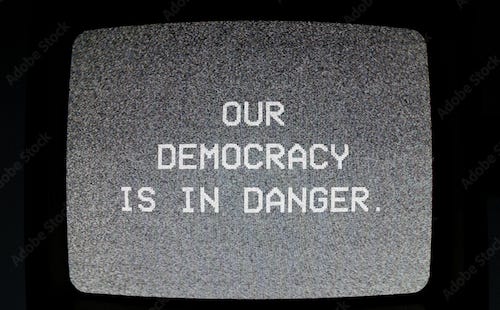Angels, Demons, and "Right-Wing Art"
The e-Right's foremost art journal has declared holy war against social media. Wat means
Is the Right bad at art? Spencer Klavan asked this question a year ago at The American Mind, and I responded here:
TV Is Always Already Progressive
The always funny and incisive Spencer Klavan wrote a salvo recently at The American Mind on the perennial problem of “conservative art”, in which he argues that this body of work has a cringe problem - in no small part because conservatives have terrible taste.
Yesterday, when I got home, I found on the doormat the latest print publication from the outlet that claims to have started the whole argument, over art and the Right: IM-1776. For those of you who aren’t very online habitués of the e-Right digital subculture that bloomed between roughly 2018 and Trump 2.0, IM-1776 emerged from and wrote for its members.
The brainchild of the intense, eccentric Italian editor Mark Granza, IM existed first as a website and, latterly, in print publications. One of its core themes has always been the nature of high art and beauty, and the future of culture in the face of stagnation and ideological capture. But IM’s latest print offering should interest even those of my readers who aren’t denizens of this subculture, because it has done two unexpected things given its outlook and origin-story: declared a crusade against social media, and invited its readers to embrace Christian faith.
In doing this, IM 7 signals the definitive end of the “scene” that spawned it, as the leading edge of contemporary culture. If social media is a dead end, what next for the ideas and inspirations it fostered? Again, IM 7 points toward one take on what comes next. For while its written paragraphs continue to engage with the question of art and the Right, taken as a whole it poses a very different one: “In the digital age, how much longer can art survive without the spiritual world?”
Art Wasn’t Always “Art”
If we look at the longer history of humans making beautiful things, it’s clear that what this term means now isn’t an eternal feature of the cultural sphere, but specific to modernity. In fact the trajectory whereby making beautiful things became “art” tracks the onset of modernity more generally. In Saving the Appearances (1957) the literary historian Owen Barfield traces the slow retreat of what he calls “participation”, which is to say our felt sense of interconnection and implication in everything we observe.
I read Owen Barfield against Jacques Derrida here, as contrasting approaches to postmodernism. Meanwhile, I’ve also argued recently that the resulting emergence of objectivity, and with it modernity, is impossible to disaggregate from the cultural transformations enabled by the printing press. This new distinctive norm of “objectivity”; of seeing things as objects, in turn helped shape the emergence of art galleries as cultural spaces, within which one consumes beautiful things in the abstract, as objects. And once established, this mode of seeing art would go on to retcon earlier work within its own paradigm.
But if you look at premodern paintings, even those hung in the de-contextualised space of a modern art gallery such as the National Gallery’s Sainsbury Wing, you will swiftly realise that these artefacts may be on display as though they created for the objectifying eye of the “art critic”. But that’s not what they are at all. On the contrary, you are looking almost exclusively at devotional objects created for a culture of participation, and whose referent is not material but spiritual.
You are not looking at artefacts that were created to be examined critically as “symbols” or “representations” of some abstraction or other, or consumed as aesthetic objects. You are not looking at “artworks” at all. You are looking at artefacts created to be venerated, perhaps as visual focus for spiritual meditation, or simply to focus a prayer for help.
Demons Were Outer Before They Were Inner
This very different understanding of what beautiful artefacts are for went hand-in-hand with an understanding of where the inspiration came from, to create them: not within an individual or around us in the physical world, but beyond in spiritual realms. We might talk today about a “genius” wrestling with his “inner demons”, but in The Discarded Image (1964), Barfield’s friend and fellow Inkling CS Lewis points out that in late antiquity “genius” referred not to individual inspiration, or an unusually gifted person, but was rather itself “the standard Latin translation of daemon.” Lewis observes that for Apuleius, writing in the second century AD, “genius” or “daemon” was understood to refer to a class of being midway between man and the angels, of which one is “allotted to each human being as his ‘witness and guardian’ throughout life”.
How did “genius” go from denoting a distinct, agentic type of spiritual being, to being a person’s “true self” and finally “his literary or artistic gifts”? Understanding this, Lewis suggests, means “grasping that great movement of internalisation, and that consequent aggrandisement of man and desiccation of the outer universe, in which the psychological history of the West has so largely consisted”.
This movement is now so fully realised that it’s taken entirely for granted as an account of where inspiration originates. This idea shows up in the written text of IM 7, where Granza describes how artists reach “deep within” to “tap into their muse”. “Their muse” is a telling phrase: for the ancients, the Muses were not just figurative language denoting a personal wellspring of inner inspiration. They were real, independent, agentic spiritual beings. It’s only through the course of what Lewis calls “that great movement of internalisation” that the Muses shrank into the personalised, metaphorical vestigial remnant form indicated by “their muse”.
And it’s in this context that Granza has declared a “crusade” against social media, in the name of Beauty. For IM 7 accurately identifies the threat posed by the internet to this version of the creative process. Social media is, Granza argues, inimical to artistic creativity (whether Right-wing or otherwise) because it incentivises “productivity” over time spent in reflection or honing one’s craft. And it’s also a threat because the internet discourages introspection as such, and thus disincentivises looking “deep within” to “tap into their muse”. Instead, now, we’re all looking outward for the immediate sugar-rush of reward from an audience.
But It’s Not Just The Death Of Art
In my observation, this is basically accurate. Spending all day scrolling really can attenuate, or at least radically reconfigure, the felt sense of inner life typical of a mind formed by long-form reading. A little while back, too, I identified the compulsive stimulation of smartphone content as a “technology of acedia”, which is to say a calculated monetisation of distractibility: an engine of anti-contemplation.
Technologies of acedia
I quit smoking more than 15 years ago, which means I’ve now been an ex-smoker for longer than I was a smoker. Or am I actually an ex-smoker? In the years since, I’ve sometimes wondered if it was less the year I spent nicotine gum that helped me over the line than another, concurrent lifestyle change: getting an iPhone, and swapping my nicotine addiction for compulsive absorption in the multiverse of my phone.
It stands to reason that a technology which hollows out our sense of internality, and replaces deep work with restless, short-form overstimulation, would also attenuate the sense of artistic inspiration coming from “within”. But what if, along with this negative development, the digital revolution also re-opens the possibility of inspiration coming from without?
Keep reading with a 7-day free trial
Subscribe to Mary Harrington to keep reading this post and get 7 days of free access to the full post archives.





